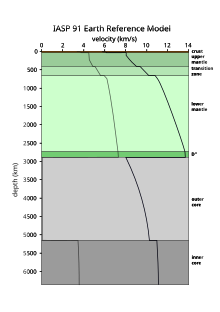410 km discontinuity
The 410 km discontinuity is a striking geological- seismic structure in the internal structure of the earth . It represents the upper limit of the mantle transition zone .
The discontinuity is characterized by a relatively rapid increase in seismic velocities with depth. Their existence was accordingly deduced from seismological studies. The designation is based on the average global depth of their occurrence approx. 410 km below the earth's surface according to the earth reference model IASP91 . In the somewhat older PREM earth model , the average depth is given as 400 km.
Scientific background
According to generally accepted scientific opinion, the 410 km discontinuity is due to a phase transition of olivine , one of the main components of mantle rock. The α-phase of the olivine changes into its β-phase, a crystal structure of the spinel structure type (also known as wadsleyite). These mineral phases are identical in their chemical composition, but differ in their crystal structure and thus in their elastic properties.
The occurrence of the phase change is linked to a specific relationship between pressure and temperature , which is expressed by the Clapeyron slope . The average depth of 410 km corresponds to a pressure of approx. 14 G Pa (gigapascals). The corresponding Clapeyron slope is given (for a temperature of 1600 K ) as +2.9 MPa / K. A more recent study assumes a significantly higher value of +4.0 MPa / K.
Strictly speaking, due to the complex chemical composition of the mantle rock, it is not a discontinuity in the narrowest sense of the word, but a gradual transition from one mineral phase to the other, extending over several kilometers to a few tens of kilometers. Both phases exist side by side within this transition area. The thickness of this mixed area is also influenced by chemical and mineral components that do not belong directly to the olivine system, such as B. water and other fluid phases. The transition area is not linear; H. the volume fraction of the β-phase does not increase uniformly with depth, so that the discontinuity appears sharper in seismological investigations than it actually is. This increase in mineral conversion is also determined by the chemical composition of the coat.
The interpretation of seismological data is naturally associated with uncertainties, since the measurements are, on the one hand, subject to errors and the interpretation itself is based on model concepts. Rock physics laboratories are now able to create temperature and pressure conditions that are assumed to be in the lowest mantle. However, since direct analyzes of the minerals in nature are not possible, the exact composition of the minerals and their chemical structure in these inaccessible depths is uncertain. Deviations from the average global depth are therefore possible and must be taken into account in the interpretation.
Anomalies
However, the depth of the underlying phase transformation can vary regionally by a few tens of km due to physical and chemical effects. An increase in the temperature in the earth's mantle - e.g. B. by an ascending plume - the Clapeyron slope requires a higher pressure for the phase transformation. As a result, the phase transition takes place at a greater depth in such a case. Regional deviations in the depth of the discontinuity are therefore specifically examined in seismology in order to obtain information about chemical or temperature anomalies in the interior of the earth and to draw conclusions about structural features in this region.
Individual evidence
- ↑ BLN Kennett & ER Engdahl: Traveltimes for global earthquake location and phase identification , Geophysical Journal International, 1991, Vol. 105, pp. 429-465
- ↑ AM Dziewoński & DL Anderson : Preliminary Reference Earth Model , Physics of the Earth and Planetary Interiors, 1981, Vol. 25, pp. 297-356
- ↑ a b C.R. Bina & G. Helffrich: Phase transition Clapeyron slopes and transition zone seismic discontinuity topography
- ↑ A. Chopelas: Thermal properties of β-Mg 2 SiO 4 at mantle pressures derived from vibrational spectroscopy: Implications for the mantle at 400 km depth , Journal of Geophysical Research , 1991, Vol. 96, pp. 11817-11829
- ↑ T. Katsura et al .: Olivine-wadsleyite transition in the system (Mg, Fe) 2 SiO 4 , Journal of Geophysical Research, 2004, Vol. 109, B02209, doi : 10.1029 / 2003JB002438 .
- ↑ L. Stixrude: Structure and sharpness of phases transitions and mantle discontinuities , Journal of Geophysical Research, 1997, Vol. 102, pp. 14835-14852
- ↑ T. Melbourne & D. Helmberger: Fine structure of the 410-km discontinuity , Journal of Geophysical Research, 1998, Vol. 103, pp. 10091-10102
- ↑ K. Chambers, A. Deuss & JH Woodhouse: Reflectivity of the 410-km discontinuity from PP and SS percursors , Journal of Geophysical Research, 2005, Vol. 110, B02301, doi : 10.1029 / 2004JB003345 .
- ↑ M. Obayashi et al .: High temperature anomalies oceanward of subducting slabs at the 410-km discontinuity , Earth and Planetary Science Letters, 2006, Vol. 243, pp. 149-158
- ^ X. Li, R. Kind & X. Yuan: Seismic study of upper mantle and transition zone beneath hotspots , Physics of the Earth and Planetary Interiors, 2003, vol. 136, pp. 79-92
